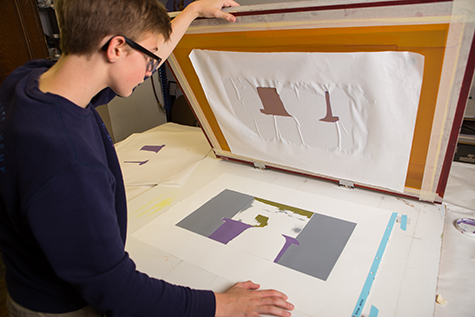The Important Overview to Recognizing Screen Printing and Its Versatile Utilizes
Screen printing has an abundant background that dates back to old times, progressing into a sophisticated strategy used throughout different industries today. This overview explores the ins and outs of the screen printing process, describing its applications in fashion, advertising, and home decoration - 10:9 Design Texas. Recognizing these fundamentals can open imaginative potential for both business and imaginative tasks. The following areas will certainly reveal necessary tips and methods to improve one's screen printing undertakings
The History of Screen Printing
Although screen printing has origins that map back centuries, its advancement reflects the creative and technical advancements of various cultures. Originating in ancient China, the method was initially used for enhancing fabrics and later infect Japan, where it became important to Ukiyo-e woodblock printing. The technique moved to Europe in the 18th century, where it gained popularity amongst craftsmens and industrial printers. The invention of photo solution in the 20th century changed screen printing, allowing for more intricate designs and greater effectiveness. Musicians like Andy Warhol better pushed its popularity, utilizing the tool to create renowned works that blended commercialism and great art. By the late 20th century, screen printing had actually established itself as a versatile strategy, utilized in style, marketing, and great art. Today, it proceeds to develop, integrating digital innovation and expanding its applications throughout numerous industries.
The Screen Printing Refine Explained
Screen printing transforms creative visions right into tangible designs via a collection of exact actions. Initially, an image is produced and after that moved onto a screen, commonly made of great mesh fabric stretched over a frame. A light-sensitive solution is put on the screen, which is revealed to light, solidifying in locations not covered by the picture. After rinsing the unhardened solution, a pattern is developed.
Next, the screen is positioned over the substratum, whether it be material, paper, or an additional product. Ink is then pressed via the open locations of the stencil utilizing a squeegee, transferring the design onto the substrate listed below. This procedure can be duplicated for numerous colors, requiring different displays for every hue. The printed thing is treated using warm to assure the ink adheres appropriately, resulting in a sturdy, dynamic style all set for use.
Types of Screen Printing Techniques

Additionally, specialized methods, such as discharge screen printing, get rid of dye from the fabric to produce softer prints, while foil screen printing uses metal foil to attain a glossy surface (10:9 Design contact). Each technique offers distinctive qualities, accommodating numerous imaginative requirements and manufacturing scales, inevitably expanding the opportunities within the screen printing domain name
Applications of Screen Printing in Various Industries

Furthermore, the signs and advertising markets make use of screen printing for creating attractive screens and banners. This approach permits strong shades and intricate designs that catch focus. In electronics, screen printing is utilized for using conductive inks to circuit boards, vital for part links. check out here The home design market accepts screen printing to generate distinct layouts on fabrics and wall art. In general, screen printing works as an essential device throughout diverse fields, improving products with customized and aesthetically attractive graphics.
Tips for Effective Screen Printing Projects
While undertaking a screen printing project, careful attention to detail can considerably enhance the final outcome. Selecting top notch products is crucial; this includes the screen, inks, and substratums. Making use of proper mesh counts can influence ink deposition and information resolution. Preparation is equally essential; detailed cleaning of screens and proper direct exposure times assure crisp prints.
Next, precise registration is crucial for multi-color prints. Using positioning tools can help achieve exact layering. Furthermore, testing prints on scrap products before manufacturing helps determine potential concerns without losing resources.

Frequently Asked Questions
What Products Are Best for Screen Printing on Textile?
Cotton and polyester blends are perfect for screen printing on fabric as a result of their longevity and ink absorption. Additionally, specialized materials like silk or canvas can generate unique structures and surfaces, enhancing the overall style top quality.
Exactly how Do I Clean and Maintain Screen Printing Equipment?
To preserve and clean screen printing devices, one must consistently wash displays with appropriate solvents, evaluate squeegees for wear, lube moving parts, and store all items in a dry, dust-free environment to extend their lifespan.
What Are the Ecological Effects of Screen Printing?
Screen printing can have considerable ecological influences, including chemical waste from sign printing near me inks and solvents, water use during cleansing procedures, and power consumption. Lasting practices and green materials are necessary for lessening these adverse results.
Can Screen Printing Be Done at Home Efficiently?
Screen printing can be properly done at home with the ideal materials and strategies. Hobbyists can create top quality prints, though success relies on their skill degree, devices, and understanding of the process included.
What Are the Prices Related To Starting a Display Printing Business?

Starting a screen printing service includes prices for devices, products, and workspace. Preliminary costs normally vary from a couple of hundred to numerous thousand dollars, depending upon the scale, quality of equipment, and wanted manufacturing ability.
Screen printing has an abundant history that dates back to old times, evolving into an innovative strategy made use of throughout different sectors today. Another method, rotary screen printing, employs round screens, assisting in continuous printing on fabric rolls, consequently improving efficiency for large productions. Furthermore, specialized strategies, such as discharge screen printing, eliminate dye from the textile to create softer prints, while foil screen printing applies metal aluminum foil to accomplish a shiny finish. In the style industry, screen printing is commonly utilized to develop vivid designs on garments, enabling brands to showcase their unique styles. Cotton and polyester blends are suitable for screen printing on fabric due to their resilience and ink absorption.